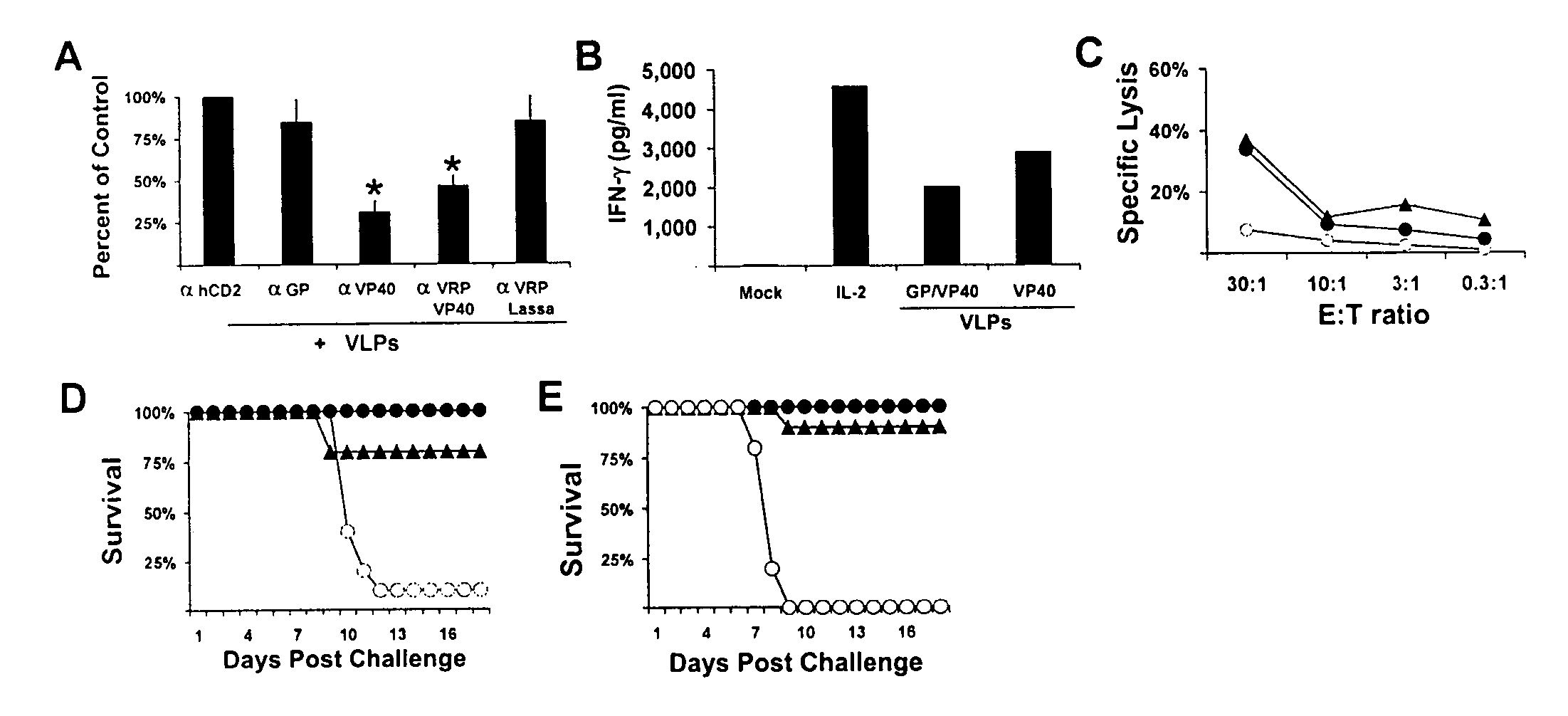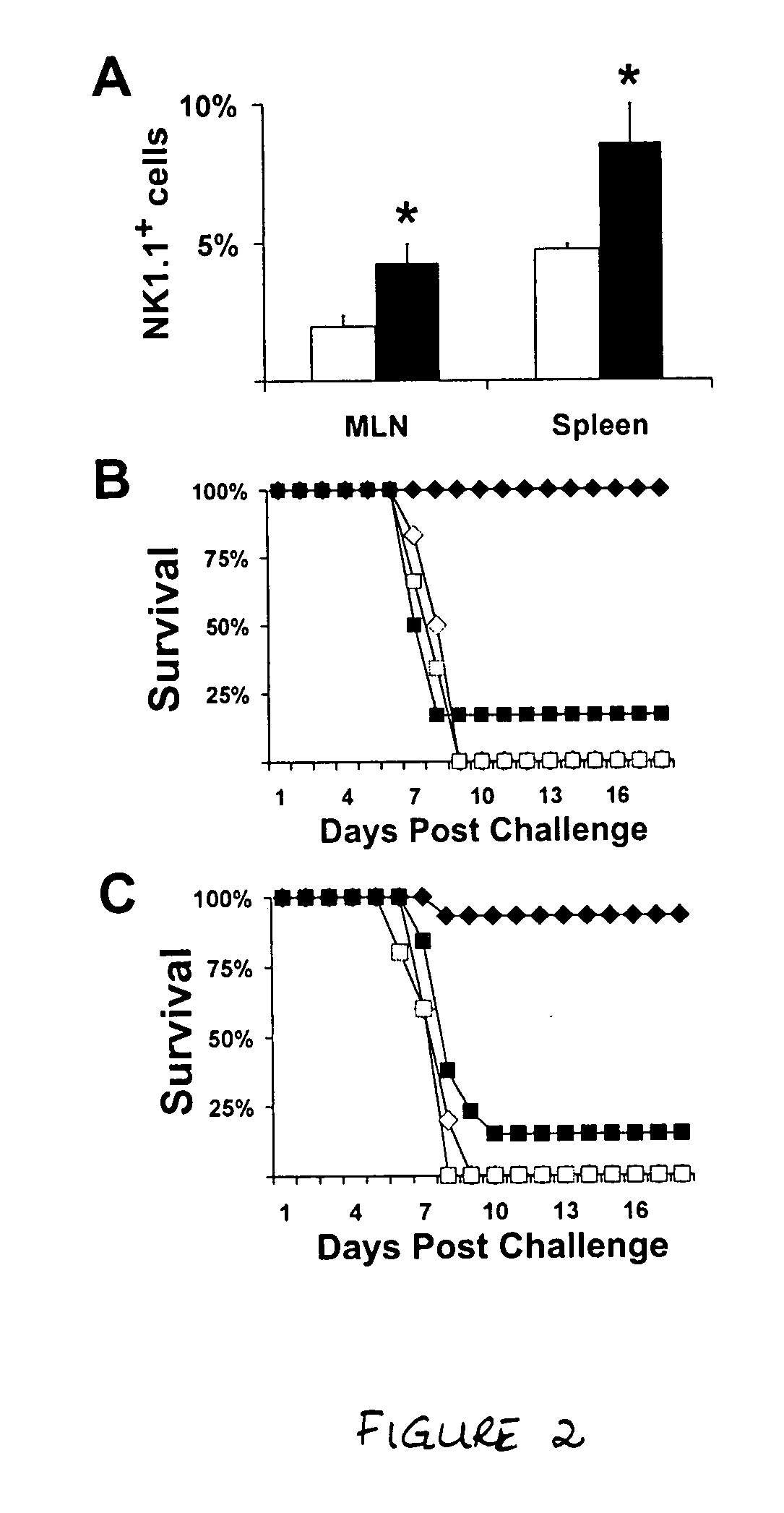Activation of natural killer (NK) cells and methods of use
a technology applied in the field of natural killer cells and methods of use, can solve the problems of unknown natural reservoir of filoviruses, poor immune responses of natural killer cells (nk), t, uncontrolled spread and growth of virus, etc., and achieves enhanced immune response, high-effect adjuvant effect, and enhanced immune system response
- Summary
- Abstract
- Description
- Claims
- Application Information
AI Technical Summary
Benefits of technology
Problems solved by technology
Method used
Image
Examples
example 1
[0104] VLPs rapidly induce protection from lethal EBOV infection. Morphologically, the VLPs are almost indistinguishable from inactivated EBOV by electron microscopy (Warfield et al., 2003, supra; Bavari et al., 2002, J. Exp. Med. 195, 593-602) or by atomic force microscopy (FIG. 1A and (Feldmann et al., 2003, Nat. Rev. Immunol. 3, 677-685). The VLPs induced potent innate immune responses, as mice injected intraperitoneally once with VLPs, 1-3 days before challenge with more than 3,000 LD50 of EBOV (Bray et al., 1999, supra) were 80-100% protected from death (FIG. 1B). However, mice injected 3 days before challenge with either irradiated, inactivated EBOV or the sucrose-purified supernatants from mock-transfected cells succumbed to EBOV challenge (FIG. 1B). Irradiating the VLPs had no effect on the outcome of these experiments (unpublished observations), suggesting that the failure of the inactivated EBOV to protect mice from EBOV infection was not simply due to the irradiation. Int...
example 2
[0105] Innate protection against EBOV requires NK cells. Although many different factors may have contributed to VLP-induced innate protection, we narrowed our search to the role of NK cells. Marked increases in NK cell activity occur early in microbial invasions and results in the recruitment of NK cells to the site of infection (Yokoyama and Scalzo, 2002, supra). VLPs recruited almost twice the number of NK cells in both the mediastinal lymph node and spleen compared to animals receiving PBS alone (FIG. 2A), suggesting VLP administration induces NK cell proliferation and / or trafficking in lymphoid tissues. To directly examine the role of NK cells in EBOV infections, NK cell-deficient mice (Kim et al., 2000, supra) were administered VLPs 3 days prior to lethal EBOV challenge. VLP-pretreatment of mice lacking functional NK cells did not protect from EBOV infection (1 / 6, FIG. 2B), unlike VLP-injected wild-type C57Bl / 6 mice (6 / 6, P=0.0076). Further, mice depleted of NK cells using ant...
example 3
[0107] NK cell responses to Ebola virus. Ebola VLPs are morphologically and antigenically similar to live EBOV [FIG. 1A and Warfield et al., 2003, supra; Bavari et al., 2002, supra; Swenson et al., 2004, FEMS Immunol. Med. Microbiol. 40, 27-31]. However, unlike VLPs, inactivated EBOV did not induce innate protection from EBOV infection or stimulate NK cell responses in vitro (FIG. 1B). Therefore, we set out to determine if murine NK cells possessed the ability to respond to live EBOV. Unlike exposure to IL-2 or VLPs, live EBOV did not induce secretion of IFN-γ, MIP-1α, or TNF-α from NK cells (FIG. 4A-C).
[0108] Several viruses, including human cytolomegalovirus, HIV, and Epstein-Barr virus replicate efficiently in NK cells (Rice et al., 1984, Proc. Natl. Acad. Sci. USA 81, 6134-6138; Chehimi et al., 1991, J. Virol. 65, 1812-1822; Kanegane et al., 2002, Crit. Rev. Oncol. Hematol. 44, 239-249; Valentin and Pavlakis, 2003, Anticancer Res. 23, 2071-2075). To determine whether the lack o...
PUM
| Property | Measurement | Unit |
|---|---|---|
| Composition | aaaaa | aaaaa |
| Immunogenicity | aaaaa | aaaaa |
Abstract
Description
Claims
Application Information
 Login to View More
Login to View More - R&D
- Intellectual Property
- Life Sciences
- Materials
- Tech Scout
- Unparalleled Data Quality
- Higher Quality Content
- 60% Fewer Hallucinations
Browse by: Latest US Patents, China's latest patents, Technical Efficacy Thesaurus, Application Domain, Technology Topic, Popular Technical Reports.
© 2025 PatSnap. All rights reserved.Legal|Privacy policy|Modern Slavery Act Transparency Statement|Sitemap|About US| Contact US: help@patsnap.com



